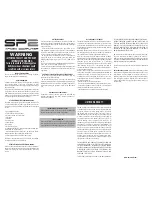
MINISYSTEM Manual Version 1.5
Page 7
Maintain a high ambient light level in the laser operation area so the eye pupil remains
constricted, thus reducing the possibility of hazardous exposure.
Post prominent warning signs near the laser operation area.
Provide enclosures for the beam path whenever possible.
Set up an energy absorber to capture the laser beam, preventing unnecessary reflections
or scattering.
CAUTION: Use of controls, adjustments or performance of procedures
other than those specified in this User's Manual may result in hazardous
radiation exposure.
Follow the instructions within this manual carefully to ensure the safe operation of your
laser. At all times during laser operation, maintenance, or servicing, avoid unnecessary
exposure to laser or collateral radiation that exceeds the accessible emission limits listed in
"Performance Standards for Laser Products," United States Code of Federal Regulations,
21 CFR 1040.10(d). This information is also available in EN60825-1:1994, Section 8.2,
titled “Measurements of Laser Radiation for Determining Classification.”
Preventative Maintenance for Safety
Preventative maintenance is required to ensure the laser remains in compliance with
Center for Devices and Radiological Health (CDRH) Regulations and European Norm (EN)
requirements. This laser product complies with Title 21 of the United States Code of
Federal Regulations, Chapter 1, Subchapter J, Parts 1040.10, as applicable, and with
EN60825-1:1994, Part 1 for a Class 4 laser, as applicable. To maintain compliance, verify
the operation of all features listed below, either annually or whenever the product has been
subjected to adverse environmental conditions, which may have affected these features
and functions.
Verify that removing the remote interlock connector prevents laser operation. This
connector is located on the rear panel of the Laser Power Supply.
Verify that an 8 second time delay exists between turning on the main power and the start
of laser firing. It must give enough warning to allow action to be taken to avoid exposure to
laser radiation.
Safety Issues
Normal use of test equipment presents a certain amount of danger due to electrical shock
because it may be necessary
for testing
to be performed where voltage is exposed.
An electrical shock causing 10 milliamps of current to pass through the heart will stop most
human heartbeats. Voltage as low as 35 VDC or 35 V
RMS
AC should be considered
dangerous and hazardous, as it can produce a lethal current under certain conditions.
Higher voltages pose an even greater threat because su ch voltage can easily produce a
lethal current. Your normal work habits should include all accepted practices that will
prevent contact with exposed high voltage and steer current away from your heart in case of
accidental contact with a high voltage. You will significantly reduce the risk factor if you
know and observe the following safety precautions:








































